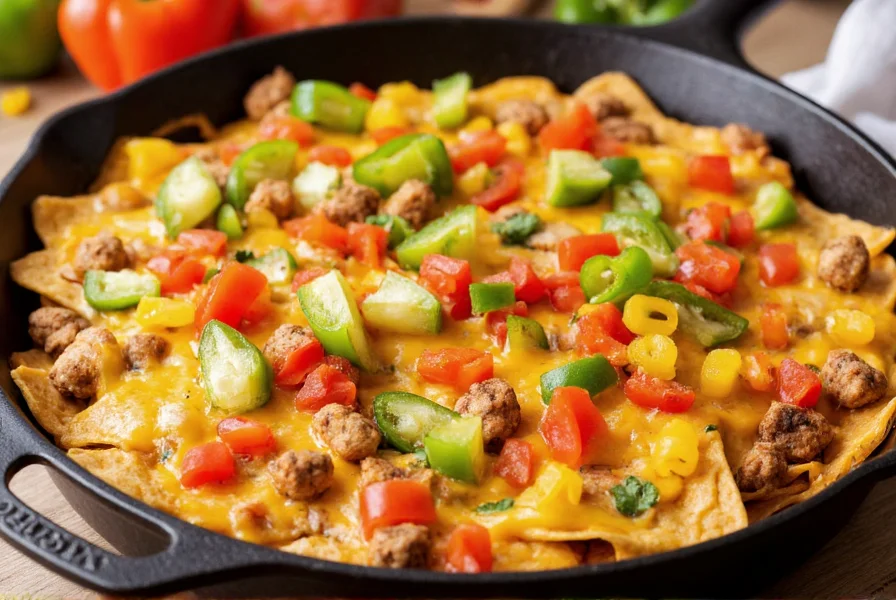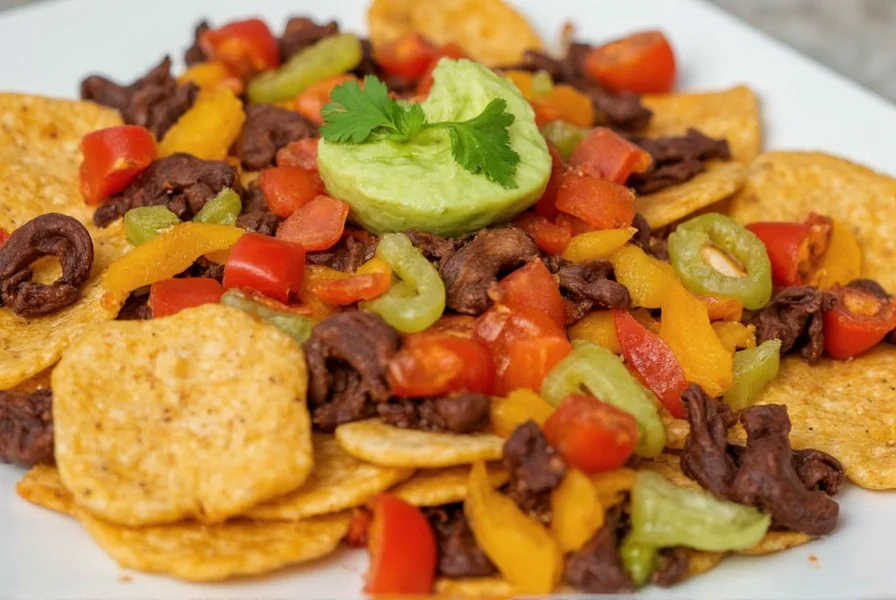Understanding Pepper Nachos: Beyond Basic Nacho Variations
When exploring pepper nachos recipe variations, it's essential to understand how different peppers transform this classic snack. While traditional nachos focus on cheese and meat toppings, pepper nachos elevate the dish by making peppers a starring ingredient rather than just an optional garnish. This culinary approach creates a more complex flavor profile and adds nutritional benefits that standard nachos often lack.
Pepper Selection Guide for Perfect Nachos
Not all peppers work equally well in nacho preparations. Understanding best peppers for nachos requires considering heat level, moisture content, and cooking behavior:
| Pepper Type | Heat Level (Scoville) | Best Preparation Method | Flavor Contribution |
|---|---|---|---|
| Bell Peppers (all colors) | 0 SHU | Thinly sliced, roasted | Sweet, crisp, colorful |
| Jalapeños | 2,500-8,000 SHU | Sliced, roasted, or pickled | Grassy, medium heat |
| Poblano | 1,000-2,000 SHU | Roasted, peeled, chopped | Earthy, mild heat |
| Serrano | 10,000-23,000 SHU | Thinly sliced raw or roasted | Sharp, bright heat |
For spicy pepper nacho recipe enthusiasts, consider creating a pepper gradient by combining multiple varieties. Start with milder peppers like poblanos as the base layer, then add medium-heat jalapeños, and finish with sparingly placed serranos for those who want extra kick. This approach accommodates different heat preferences while maintaining structural integrity—critical for how to make pepper nachos that don't get soggy.

Essential Components of Quality Pepper Nachos
Creating exceptional pepper nachos requires attention to several key elements beyond just the peppers themselves:
Chip Selection Matters
Thick, restaurant-style tortilla chips provide the necessary structural support to handle multiple toppings without breaking. Look for corn tortilla chips with ridges that help trap cheese and pepper juices. Avoid thin, overly salted varieties that become soggy quickly when combined with moist ingredients like roasted peppers.
Cheese Strategy
The cheese selection significantly impacts pepper nachos texture and meltability. A combination works best:
- Queso fresco - Provides crumbly texture and salty finish
- Monterey Jack - Melts smoothly without becoming greasy
- Pepper Jack - Adds complementary heat that enhances the peppers
Step-by-Step Preparation Guide
Follow this method for perfect pepper nachos every time, avoiding the common pitfall of soggy chips:
- Preheat oven to 375°F (190°C) with rack in upper third position
- Arrange single layer of tortilla chips on baking sheet
- Sprinkle ⅓ of your cheese blend evenly over chips
- Add thin layer of prepared peppers (avoiding excess moisture)
- Repeat layers two more times, finishing with cheese on top
- Bake 8-12 minutes until cheese is fully melted but chips remain crisp
- Remove immediately and add fresh toppings like cilantro or lime zest
Advanced Techniques for Restaurant-Quality Results
Professional kitchens employ several pepper nachos cooking secrets worth adopting at home:
Moisture Management
Peppers naturally contain water that can make nachos soggy. To prevent this:
- Roast peppers first to reduce moisture content by 30-40%
- Pat roasted peppers dry with paper towels before adding to nachos
- Season peppers with salt 10 minutes before use to draw out excess moisture
Layering Strategy
Proper layering prevents the common pepper nachos problem of uneven distribution. Instead of piling all toppings on top, create three distinct layers:
- Bottom layer: Chips with light cheese coating (creates moisture barrier)
- Middle layer: Peppers and additional cheese (main flavor component)
- Top layer: Chips with final cheese coating (provides structural integrity)

Dietary Adaptations for All Preferences
Pepper nachos easily accommodate various dietary needs without sacrificing flavor:
Vegetarian and Vegan Options
For vegetarian pepper nachos, simply omit meat toppings. For vegan versions:
- Use cashew-based cheese alternatives that melt well
- Add nutritional yeast for cheesy flavor
- Include black beans for protein content
Gluten-Free Considerations
Most nachos are naturally gluten-free, but verify:
- Check tortilla chip ingredients for wheat additives
- Avoid beer-based cheese sauces
- Use corn tortillas exclusively
Avoiding Common Pepper Nachos Mistakes
Even experienced cooks make these frequent pepper nachos errors:
- Overloading with toppings - Stick to 3-4 components maximum to maintain structural integrity
- Using wet ingredients - Drain canned peppers thoroughly; pat fresh peppers dry
- Incorrect oven temperature - Too hot causes burnt cheese before chips warm; too low creates soggy results
- Serving too late - Nachos lose crispness within 5 minutes of baking
Serving Suggestions and Pairings
Maximize your pepper nachos dining experience with these complementary pairings:
- Cold beverages - Mexican lager or agua fresca to balance heat
- Cooling accompaniments - Avocado crema or sour cream for heat mitigation
- Side salads - Simple arugula salad with lime vinaigrette cuts richness
- Protein additions - Shredded chicken or black beans for heartier meal
Storage and Reheating Guidelines
While pepper nachos are best enjoyed fresh, proper storage can extend their life:
- Store components separately for optimal reheating results
- Reheat chips alone in oven before adding toppings
- Avoid microwave reheating which guarantees sogginess
- Consume within 24 hours for best quality
Frequently Asked Questions
What's the difference between pepper nachos and regular nachos?
Pepper nachos specifically feature various types of peppers as essential components rather than optional toppings. While regular nachos might include peppers as one of many possible additions, pepper nachos highlight peppers as starring ingredients that define the dish's flavor profile, texture, and visual appeal. The preparation method also differs, with special attention to moisture management when using peppers to prevent sogginess.
Which peppers work best for nachos that won't get soggy?
Poblano and Anaheim peppers work best for maintaining crispness as they have lower moisture content than bell peppers. Roasting these peppers first reduces their water content by 30-40%, significantly decreasing the risk of soggy nachos. If using bell peppers, remove seeds and membranes thoroughly and pat dry with paper towels before adding to your nachos.
Can I make pepper nachos without an oven?
Yes, you can prepare pepper nachos on the stovetop using a cast-iron skillet. Layer chips with cheese and peppers, then cover with a lid to allow the cheese to melt from the trapped heat. For best results, work in small batches and avoid adding too many moist ingredients. Air fryers also work well for smaller portions at 350°F for 5-7 minutes.
How do I prevent my pepper nachos from becoming too spicy?
To control heat levels in pepper nachos, remove seeds and white membranes from hot peppers (where most capsaicin resides), use milder peppers like poblanos as your base, and provide cooling accompaniments like avocado crema or sour cream. You can also create a pepper gradient with milder peppers on the bottom layers and hotter varieties only on the top for those who want extra heat.
What's the ideal cheese-to-chip ratio for pepper nachos?
The ideal ratio is approximately 4 ounces of shredded cheese per 6 ounces of tortilla chips. This provides enough cheese to bind the nachos without overwhelming the chips or making them soggy. For layered nachos, distribute the cheese evenly across three layers rather than concentrating it all on top for better melt and coverage.











 浙公网安备
33010002000092号
浙公网安备
33010002000092号 浙B2-20120091-4
浙B2-20120091-4